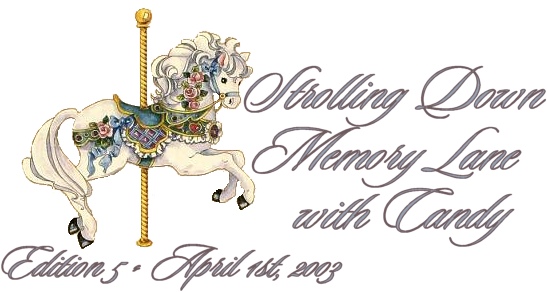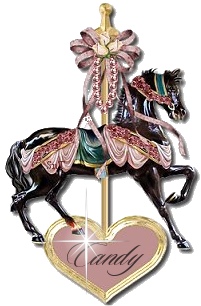Welcome Everyone!

Remember our excitement at hearing the music before we even saw the Merry Go Round...remember the experience of picking just the right horse to ride on. As a child we had our picture taken as we went round and round, as a parent we took pictures of our child's first ride. The Merry Go Round takes us back in time, to when things were simpler and we could go round and up and down and forget all our cares.

The history of carousels or Merry Go Round, dates back to the 12th century. In order to test a rider’s skill, scented clay balls were thrown from one Arabian horseman to another. If there were riders that were untouched by the scent of the clay, they were considered to be superior riders. The French in the 17th century were able to change the ancient clay. A wheel which had wooden arms and suspended horses was used in place of the ancient clay. A pole was placed in the center of a circle, along with a wooden horse, which rotated around the pole. The object of the game was for the rider to attempt to spear a small brass ring on the outside section of the machine. In a tournament-type game during the late 1700’s or early 1800’s, this machine was given the name of ‘carousel’. With the reign of Henry IV, the carousel was used as the entertainment. The entertainment consisted of pageants, drills, and contests with participating troops of costumed horsemen. Located between the Tuileries Garden and the Louvre in Paris, is The Place du Carrousel. This was named after a carousel given by Louis XIV in 1662. A make believe carousel was created with hobbyhorses by an inventive Parisian toy maker. He wanted to give everyone an opportunity to enjoy these spectacular carousels because normally only those of nobility could enjoy. Yes, you guessed it! The platform did turn very slowly so that everyone, children and adults, could enjoy this event. The Parisian children were in awe! Soon the ride was spreading to America.
Poles with brass fixtures, glass mirrors that beveled, and incandescent lighting was added to the original carousels. Band organ music was introduced to add the magic to the ride. A wooden horse manufacturer, Allen Herschell, sold his firm in 1950 to a maker of fiberglass horses. Today the authentic wooden horses are valued from $200 to $80,000, depending on their age and condition. These simple magnificent machines of the past were being developed into elaborate machines. The carousel as an art form between 1867 and 1930 no longer exists. Luckily, the students of both Art and History are now recognizing it. The brass rings that were on the horses on the older carousels were present so that people could try to grab in order to get a free ride. Today the brass rings are mostly gone. Riders are treated to this fun in a few places.
Usually the most decorative are the horses that face the public. This is referred to as the ‘romance side’. The horse that is on the outside directly behind the chariot is referred to as the ‘lead (King) horse’. These are considered the fanciest on the ride. The benches for people who do not want to hold the reins are called lover’s seats. These are also referred to as ‘chariots (gondolas)’.
I also found them to be a great place to sit, relax and watch the world go by. Find a Merry Go Round and take your kids for a ride, or just be a kid again, and take one yourself. A great way to say "Hello Spring!"


